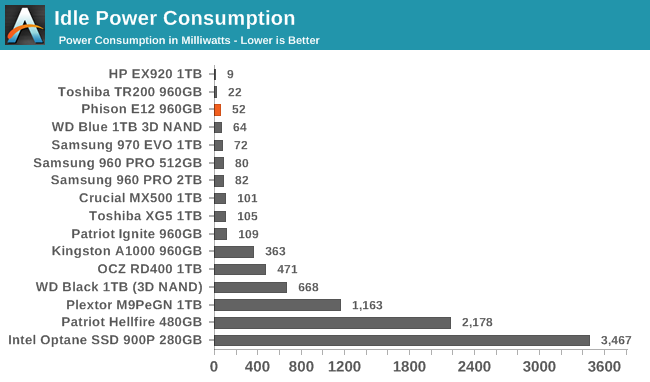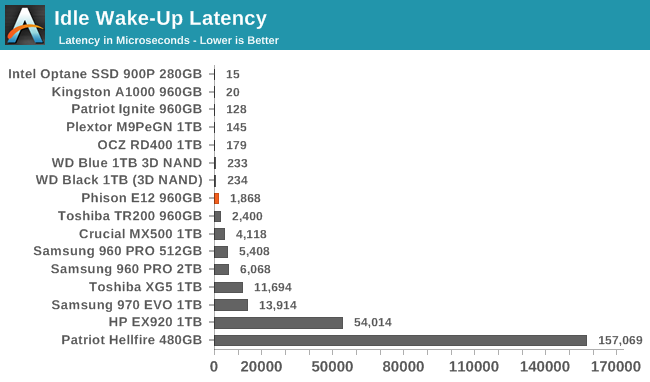The Phison E12 Reference Design Preview: A Next-Gen NVMe SSD Controller
by Billy Tallis on July 18, 2018 10:30 AM ESTPower Management Features
Real-world client storage workloads leave SSDs idle most of the time, so the active power measurements presented earlier in this review only account for a small part of what determines a drive's suitability for battery-powered use. Especially under light use, the power efficiency of a SSD is determined mostly be how well it can save power when idle.
For many NVMe SSDs, the closely related matter of thermal management can also be important. M.2 SSDs can concentrate a lot of power in a very small space. They may also be used in locations with high ambient temperatures and poor cooling, such as tucked under a GPU on a desktop motherboard, or in a poorly-ventilated notebook.
| Phison E12 960GB Engineering Sample NVMe Power and Thermal Management Features |
|||
| Controller | Phison PS5012-E12 | ||
| Firmware | ECFM11.0 | ||
| NVMe Version |
Feature | Status | |
| 1.0 | Number of operational (active) power states | 3 | |
| 1.1 | Number of non-operational (idle) power states | 2 | |
| Autonomous Power State Transition (APST) | Supported | ||
| 1.2 | Warning Temperature | 70 °C | |
| Critical Temperature | 90 °C | ||
| 1.3 | Host Controlled Thermal Management | Supported | |
| Non-Operational Power State Permissive Mode | Not Supported | ||
The Phison E12 implements most of the optional power and thermal management features defined by the current NVMe 1.3 standard. The two idle states advertise great power savings and reasonably quick transition times.
| Phison E12 960GB Engineering Sample NVMe Power States |
|||||
| Controller | Phison PS5012-E12 | ||||
| Firmware | ECFM11.0 | ||||
| Power State |
Maximum Power |
Active/Idle | Entry Latency |
Exit Latency |
|
| PS 0 | 8.9 W | Active | - | - | |
| PS 1 | 2.3 W | Active | - | - | |
| PS 2 | 1.8 W | Active | - | - | |
| PS 3 | 49 mW | Idle | 2 ms | 2 ms | |
| PS 4 | 1.8 mW | Idle | 25 ms | 25 ms | |
Note that the above tables reflect only the information provided by the drive to the OS. The power and latency numbers are often very conservative estimates, but they are what the OS uses to determine which idle states to use and how long to wait before dropping to a deeper idle state.
Idle Power Measurement
SATA SSDs are tested with SATA link power management disabled to measure their active idle power draw, and with it enabled for the deeper idle power consumption score and the idle wake-up latency test. Our testbed, like any ordinary desktop system, cannot trigger the deepest DevSleep idle state.
Idle power management for NVMe SSDs is far more complicated than for SATA SSDs. NVMe SSDs can support several different idle power states, and through the Autonomous Power State Transition (APST) feature the operating system can set a drive's policy for when to drop down to a lower power state. There is typically a tradeoff in that lower-power states take longer to enter and wake up from, so the choice about what power states to use may differ for desktop and notebooks.
We report two idle power measurements. Active idle is representative of a typical desktop, where none of the advanced PCIe link or NVMe power saving features are enabled and the drive is immediately ready to process new commands. The idle power consumption metric is measured with PCIe Active State Power Management L1.2 state enabled and NVMe APST enabled if supported.


The active idle power draw of the Phison E12 is pretty good: slightly higher than the smaller Phison E8 controller and significantly more power-hungry than many SATA SSDs, but half the draw of most other high-end NVMe SSDs. The HP EX920 draws about 20% more in its active idle state.
With all the power management features turned on, the Phison E12 can no longer match the SM2262 controller in the HP EX920 but it does provide an incremental improvement over most other high-end NVMe controllers. Given how problematic NVMe power management was for Phison's earlier controllers even after several firmware revisions, this is a very welcome result.

The idle wake-up latency is slightly faster than the drive advertises for PS3, and the the power draw was also pretty close to spec for that power state. Aside from not being able to enter PS4 on our desktop testbed (a very common limitation), the power management situation on the Phison E12 seems to be trouble-free.










28 Comments
View All Comments
DigitalFreak - Wednesday, July 18, 2018 - link
Another high end competitor is always a welcome site. Hopefully it will push prices down further.Mikewind Dale - Wednesday, July 18, 2018 - link
And that idle power consumption is great. Looks like we have a great SSD for laptops.Amoro - Wednesday, July 18, 2018 - link
Wonder why they didn't use DDR4L?FATCamaro - Wednesday, July 18, 2018 - link
All DDR4 is the same. There are only improvements in LPDDR4 which I haven’t seen anywhere yetIII-V - Wednesday, July 18, 2018 - link
DDR4L operates at a lower voltage, and consumes 80% of the power of DDR4. Where LPDDR shines is with standby power, which is far lower than DDR4 and DDR4L.bug77 - Wednesday, July 18, 2018 - link
For laptops, SATA will always be the less power hungry choice.Death666Angel - Thursday, July 19, 2018 - link
If you can do more tasks in the same amount of time, I think a lot of people will not mind a fractional increase in power consumption. How much of a fraction is the SSD power consumption on modern laptops anyway? LCD should still be #1 over the course of a full battery charge.bug77 - Thursday, July 19, 2018 - link
It's about idle power. It's higher on PCIe.And you can rarely get more things done on a NVMe drive, 4k random reads are only slightly better than AHCI. And 4k random reads is what you do most of the time ;)
Lolimaster - Thursday, July 19, 2018 - link
And unless you want a desktop replacement laptop nvme makes very little sense for 95% of the users (5% being 4k video editiors).bug77 - Friday, July 20, 2018 - link
There could be that some laptops only have M2 slots for expansion?